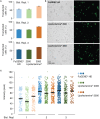A Guide to Transient Expression of Membrane Proteins in HEK-293 Cells for Functional Characterization
- PMID: 27486406
- PMCID: PMC4949579
- DOI: 10.3389/fphys.2016.00300
A Guide to Transient Expression of Membrane Proteins in HEK-293 Cells for Functional Characterization
Abstract
The human embryonic kidney 293 (HEK-293) cells are commonly used as host for the heterologous expression of membrane proteins not least because they have a high transfection efficiency and faithfully translate and process proteins. In addition, their cell size, morphology and division rate, and low expression of native channels are traits that are particularly attractive for current-voltage measurements. Nevertheless, the heterologous expression of complex membrane proteins such as receptors and ion channels for biological characterization and in particular for single-cell applications such as electrophysiology remains a challenge. Expression of functional proteins depends largely on careful step-by-step optimization that includes the design of expression vectors with suitable identification tags, as well as the selection of transfection methods and detection parameters appropriate for the application. Here, we use the heterologous expression of a plant potassium channel, the Arabidopsis thaliana guard cell outward-rectifying K(+) channel, AtGORK (At5G37500) in HEK-293 cells as an example, to evaluate commonly used transfection reagents and fluorescent detection methods, and provide a detailed methodology for optimized transient transfection and expression of membrane proteins for in vivo studies in general and for single-cell applications in particular. This optimized protocol will facilitate the physiological and cellular characterization of complex membrane proteins.
Keywords: electrophysiology; fluorescent imaging; heterologous expression; human embryonic kidney 293 cells; membrane proteins; transfection.
Figures




Similar articles
-
GORK, a delayed outward rectifier expressed in guard cells of Arabidopsis thaliana, is a K(+)-selective, K(+)-sensing ion channel.FEBS Lett. 2000 Dec 8;486(2):93-8. doi: 10.1016/s0014-5793(00)02248-1. FEBS Lett. 2000. PMID: 11113445
-
Ion channels in guard cells of Arabidopsis thaliana (L.) Heynh.Planta. 1997;202(1):18-27. doi: 10.1007/s004250050098. Planta. 1997. PMID: 9177048
-
New structure and function in plant K+ channels: KCO1, an outward rectifier with a steep Ca2+ dependency.EMBO J. 1997 May 15;16(10):2565-75. doi: 10.1093/emboj/16.10.2565. EMBO J. 1997. PMID: 9184204 Free PMC article.
-
Endogenous channels in HEK cells and potential roles in HCN ionic current measurements.Prog Biophys Mol Biol. 2006 Jan-Apr;90(1-3):26-37. doi: 10.1016/j.pbiomolbio.2005.05.002. Epub 2005 Jun 8. Prog Biophys Mol Biol. 2006. PMID: 15979128 Review.
-
Signal transduction and ion channels in guard cells.Philos Trans R Soc Lond B Biol Sci. 1998 Sep 29;353(1374):1475-88. doi: 10.1098/rstb.1998.0303. Philos Trans R Soc Lond B Biol Sci. 1998. PMID: 9800209 Free PMC article. Review.
Cited by
-
The Arabidopsis thaliana K+-Uptake Permease 5 (AtKUP5) Contains a Functional Cytosolic Adenylate Cyclase Essential for K+ Transport.Front Plant Sci. 2018 Nov 13;9:1645. doi: 10.3389/fpls.2018.01645. eCollection 2018. Front Plant Sci. 2018. PMID: 30483296 Free PMC article.
-
Fluorescence-Based Measurements of Membrane-Bound Angiotensin Converting Enzyme 2 Activity Using Xenopus Laevis Oocytes.Biosensors (Basel). 2022 Aug 4;12(8):601. doi: 10.3390/bios12080601. Biosensors (Basel). 2022. PMID: 36004997 Free PMC article.
-
Cutting-Edge HEK293T Protein-Integrated Lipid Nanostructures: Boosting Biocompatibility and Efficacy.Int J Mol Sci. 2024 Mar 14;25(6):3294. doi: 10.3390/ijms25063294. Int J Mol Sci. 2024. PMID: 38542268 Free PMC article.
-
Plant Membrane Transport Research in the Post-genomic Era.Plant Commun. 2019 Dec 10;1(1):100013. doi: 10.1016/j.xplc.2019.100013. eCollection 2020 Jan 13. Plant Commun. 2019. PMID: 33404541 Free PMC article. Review.
-
Quantitative Bio-Imaging Tools to Dissect the Interplay of Membrane and Cytoskeletal Actin Dynamics in Immune Cells.Front Immunol. 2021 Jan 11;11:612542. doi: 10.3389/fimmu.2020.612542. eCollection 2020. Front Immunol. 2021. PMID: 33505401 Free PMC article. Review.
References
-
- Backliwal G., Hildinger M., Chenuet S., Wulhfard S., De Jesus M., Wurm F. M. (2008a). Rational vector design and multi-pathway modulation of HEK 293E cells yield recombinant antibody titers exceeding 1 g/l by transient transfection under serum-free conditions. Nucleic Acids Res. 36, e96. 10.1093/nar/gkn423 - DOI - PMC - PubMed
LinkOut - more resources
Full Text Sources
Other Literature Sources
Miscellaneous

